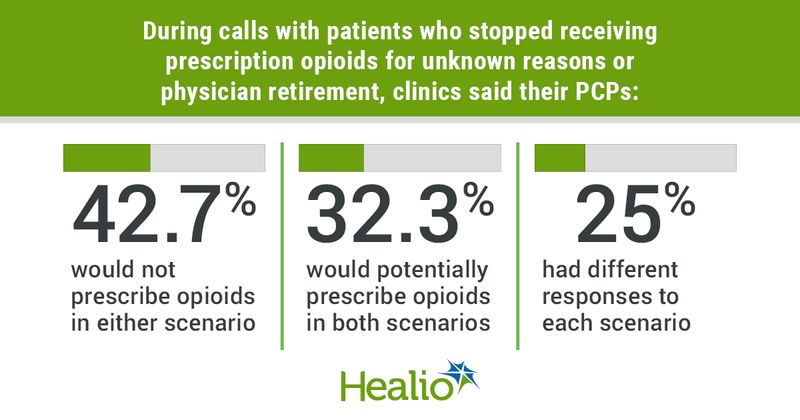Patients taking opioids for chronic pain may face barriers seeking care
Individuals taking prescription opioids for chronic pain may face difficulties scheduling new patient appointments at primary care clinics and continuing to receive their prescriptions, according to research published in Pain.
“Even if you think that someone is using opioids for a reason other than pain, or that long-term opioids are not an effective pain care strategy, those are exactly the patients we in primary care should be seeing,” Pooja Lagisetty, MD, MSc, a general internal medicine physician at Michigan Medicine, said in a press release. “Restricting their primary care access limits their ability to engage in pain-focused care and potentially addiction-focused care.”

Lagisetty and colleagues conducted a study in which simulated patients called primary care clinics. The researchers used the health care database IQVIA OneKey to collect information on primary care clinics from three states with low, middle and high overdose death rate strata based on a report from the Kaiser Family Foundation.
The simulated patients called 452 primary care clinics twice, with a period of time passing between each call. In one call to the clinics, the simulated patient said they were looking for a new primary care clinic because their provider retired, and in the other, they said that it was because previous provider stopped prescribing them opioids for an unspecified reason. During each call, the simulated patient asked primary care clinics if providers would potentially continue prescribing them opioids after a new patient visit. The simulated patients, who said they were covered by major insurer, also said they had been taking prescription opioids for pain for years.
All the clinics called by simulated patients said that they were taking new patients. Among them, 42.7% said they would not prescribe opioids to patients in both scenarios.
The researchers found that just 32.3% of clinics said their clinicians would potentially prescribe opioids to the simulated patients in both calls.
The researchers also found that 25% of clinics had differing responses depending on the simulated patient. Respondents were nearly twice as likely to say that a primary care physician from their clinic may prescribe opioids if the patient’s previous physician retired than if they said their last PCP stopped prescribing opioids without giving a reason (OR = 1.83; 95% CI, 1.23-2.76).
Lagisetty and colleagues also found that 87% of clinics would accept and schedule the patients in both scenarios, regardless of whether they were willing to prescribe opioids to these patients.
According to the researchers, 4% of clinics indicated that they were unwilling to schedule a visit to patients in both scenarios, and 9.1% indicated that they would respond differently in each scenario.
“This suggests that many clinics are likely just shutting their door to any patient needing an opioid prescription despite the reason for needing a new provider,” Lagisetty said in the press release. “Clinics often stated to the patient that this was due to new policies, fear of legal ramifications or administrative burdens.”
References:
Lagisetty P, et al. Pain. 2021;doi:10.1097/j.pain.0000000000002145.

